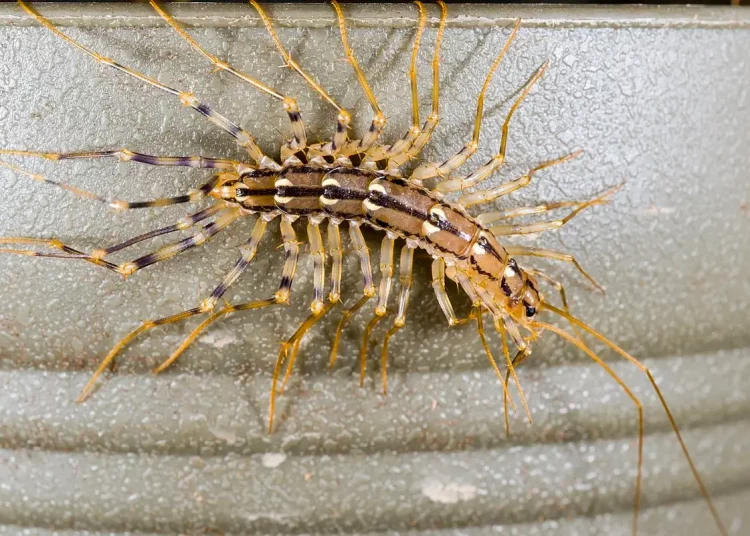Are you curious about house centipedes and if they pose a danger to your home and family? Many people mistakenly believe the myths surrounding these tiny creatures, leading to unnecessary fear and confusion.
This article will explore the facts and dispel the myths regarding house centipedes. So you can make an informed decision about what level of risk (if any) these bugs pose in your home.
What do house centipedes look like?
House centipedes are long, thin insects ranging from 1/8th of an inch to one inch.
They vary in color from yellowish-brown to gray and have 15 pairs of legs slightly longer than the body segments behind them.
They also have long antennae that curve back towards their heads, which helps them sense their environment and search for prey.
Where do house centipedes live?
House centipedes prefer moist environments like basements or bathrooms where there is plenty of food available for them to eat (like other insects).
Since they thrive in damp conditions, ensuring your home is well-ventilated and free from excess moisture is important if you want to discourage them from occupying residence inside your walls or underneath furniture.
Common Misconceptions About House Centipedes
There are several common misconceptions about house centipedes that need to be addressed. The most prominent myth is that house centipedes bite humans, which is incorrect. Other myths include:
- House centipedes are harmful to humans: This is a common misconception, as house centipedes are not venomous and do not bite or sting humans. They may defend themselves if they feel threatened, but they do not pose a serious threat to people.
- House centipedes carry diseases: This is not true. House centipedes do not carry diseases and are not known to transmit any illnesses to humans.
- House centipedes are pests: While house centipedes may be considered pests by some people, they are beneficial insects. They feed on other insects, such as spiders, silverfish, and cockroaches, which can help to control these pest populations in the home.
- House centipedes reproduce quickly: House centipedes do not reproduce quickly and do not lay large numbers of eggs. Female house centipedes lay just a few eggs at a time, and it can take several months for the eggs to hatch.
- House centipedes are attracted to dirty homes: This is not necessarily true. House centipedes are attracted to damp, humid environments, and they can be found in both clean and dirty homes.
- House centipedes only come out at night: While house centipedes are nocturnal and are more active at night, they can also be seen during the day, particularly if they are searching for food or shelter.
- House centipedes only live in basements: While they are often found in basements and crawl spaces, they can also be found in other home parts, such as bathrooms, kitchens, and attics.
- House centipedes are difficult to kill: House centipedes are relatively easy to kill, as they do not have a hard exoskeleton and are vulnerable to most pest control methods.
- House centipedes are native to North America: House centipedes are not native to North America and are native to the Mediterranean region. They have spread to other parts of the world, including North America, through human activity.
- House centipedes are rare: House centipedes are not particularly rare and can be found in many homes and buildings around the world. They are more common in damp, humid environments and are often found in basements, crawl spaces, and bathrooms.
Are house centipedes dangerous?
House centipedes are not dangerous. Despite their intimidating appearance, they pose no threat to humans. They are beneficial around the home due to their insect-eating habits.
They are mostly harmless, rarely bite, and can even be used as pest control when infestations occur.
You might be interested: Spring into Gardening: How to Start a Garden for Beginners
Do house centipedes pose a threat to humans?
No, house centipedes pose no threat to humans. They are not known to spread any disease or illness, and their venom-producing glands are only used for self-defense against prey.
If you find a house centipede in your home, the best course of action is to leave it alone, as they will eventually leave on their own.
Can house centipedes bite humans?
House centipedes are an oft-misunderstood creature. Though their wriggling anxious motions may make humans uncomfortable, they typically pose no threat to people and their property.
Most species of house centipede cannot even bite humans because their mouthparts cannot penetrate the skin.
Instead, they feed on insects and other small arthropods like spiders, worms, and cockroaches that they find in the home.
When faced with a house centipede, it is recommended that the best course of action is to leave it alone or gently scoop it up with a cup or jar and release it out of the doors.
Can house centipedes damage furniture or other household items?
House centipedes are not known to damage furniture or other household items. However, they may become a nuisance if they infest your home, as they can be difficult to remove and will likely cause distress.
If you do find house centipedes in your home, it is essential to take steps to reduce their numbers and prevent an infestation from occurring.
This can include sealing cracks and crevices, reducing the amount of clutter in your home, and vacuuming regularly. It is also important to keep food sealed and remove any sources of standing water.
You might be interested: The Importance of P-Trap in Your Plumbing System
Do house centipedes eat clothing or other materials?
House centipedes do not typically eat clothing or other materials found in a home; instead, they feed on live prey such as spiders, ants, silverfish, and cockroaches.
Since these types of pests can be difficult to get rid of without chemical treatments, having house centipedes around can help naturally keep your home free of unwanted pests.
How do house centipedes benefit the ecosystem within a home?
House centipedes are beneficial around the home due to their insect-eating habits. They help keep other pest populations in check, which can be helpful if you avoid using chemical treatments and pesticides.
In addition, house centipedes also help aerate and mix soil, aiding in decomposition, nutrient cycling, and water infiltration. This can help maintain your home’s ecosystem’s overall health and balance.
Conclusion
In summary, here are some key facts about house centipedes:
- They are not harmful to humans and do not carry diseases.
- They are beneficial pests, as they feed on other insects, including spiders and silverfish.
- They are attracted to damp, humid environments and are often found in basements, crawl spaces, and bathrooms.
- They are fast-moving and can run up walls and across ceilings.
It is important to separate fact from fiction regarding house centipedes, as many myths and misconceptions about these insects exist. They are often misunderstood and feared, but they are helpful to have around, as they help to control other pest populations in the home.
To coexist with house centipedes in the home, there are a few simple tips you can follow:
- Remove sources of moisture and humidity, as house centipedes are attracted to damp environments.
- Seal cracks or openings in the foundation or walls to prevent house centipedes from entering the home.
- Use caulk or expanding foam to seal gaps around pipes, windows, and doors.
- Use a dehumidifier to keep the air dry and reduce humidity levels in the home.
- Use natural pest control methods, such as diatomaceous earth or boric acid, to control other insects in the home. This can help to reduce the food source for house centipedes and discourage them from staying in the home.




















